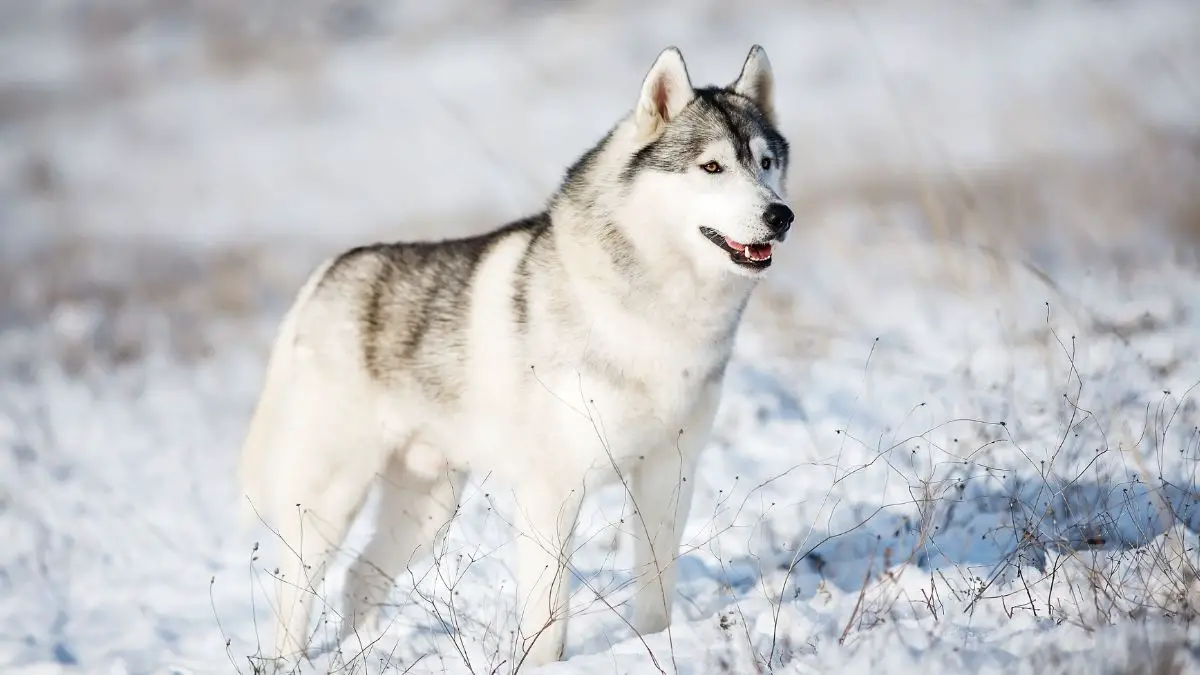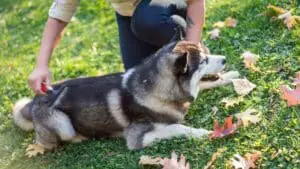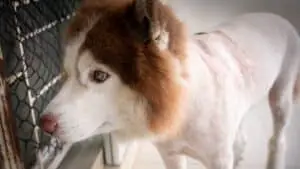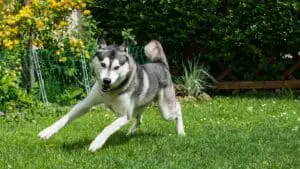How Cold Can Huskies Tolerate? What Is Too Cold for Them?
If you have a Siberian Husky as your pet bud, you already know that your fur baby can bear extremities of cold weather. Huskies love wandering about even in below-zero temperatures. If this is something that worries you, learn all about how cold Huskies can tolerate.
Thanks to their protective double coat, Huskies can withstand a frigid climate. They can thrive in temperatures as low as -50 degrees F or -51 degrees C.
It enhances one’s curiosity when you see your Husky is playful and wanders outside during the snowy weather. It is a bizarre fact, but it’s the definite truth. To stop this curious question from bothering you, go on to give this article a good read.
Table of Contents
How Do Huskies Keep Themselves Warm In The Winter?
Huskies have a thick double coat of fur and a large amount of fat underneath their skin. They preserve heat by insulating themselves with body fat and fur.
We don’t mean that having an overweight Husky is ok. We are talking about a layer of fat that is natural and healthy. The double coat plays a significant role. During the winter, the two hairy layers will keep your husky warm.
Long Water-Resistant Hair Keeps Them Dry
Their undercoat, made up of short strands, forms a dense layer of insulation that keeps his body warm.
Built-In Earmuffs For Winter
Every Siberian Husky has dense, fine hair that covers the delicate ear. The mechanism retains heat and prevents frostbite.
Running Keeps The Paws Warm
The blood flows faster through the legs of any dog. The blood warms up before returning to the body in this manner. Run or a jog with your Husky is an excellent way to beat the chill.
For Frigid Winter Days, A Furry Husky Tail Is Ideal
Siberian Huskies, as previously said, have several biological traits that aid in their survival in cold conditions. Huskies, on the other hand, are all distinctive and adapt in different ways. It also depends on how accustomed the Husky is to the changing seasons and how cold the winters are in your area.
Signs That Show Your Siberian Husky Is Cold
Here are six signs that show your Siberian Husky is feeling cold.
Shivering And Trembling
The initial and most common sign that humans show in the cold weather is shivering. Similarly, shivering and trembling are severe signs that tell your dog is suffering from the cold. Next, muscles start contracting and begin to shake in small movements, intending to expend energy. Instead, it leads to the generation of heat inside the Husky’s body.
When you see your Siberian Husky shaking or trembling in the cold environment, immediately get him inside the house. This movement in them will usually be noticeable for you. As soon as you see some shivers in your pet’s body, rush back home.
Tucked Tail And A Hunched Back
Another sign of a Husky feeling cold is bending the back or tucking its tail between the hind legs. Head back inside the house when you observe this symptom.
Ice On Their Fur
This symptom means that your Husky’s body is impotent to generate a sufficient amount of warmth within. In that case, the robust double coat fur in its body becomes ineffective.
If there is not enough heat that melts ice on the hair, the protective coat’s insulation capacity is highly affected. We recommend taking immediate steps and wrapping your pet bud with something warm.
Body Language And Behavior
The most significant sign of feeling cold is when a Husky behaves strangely. If you can spot movements that signal fear, anxiety, or stress, take your Husky inside at that moment. There are many possible symptoms of anxiety in dogs.
Your Siberian Husky might start barking constantly and loudly to notify you. He would whine and bark while looking into your own eyes. If he makes these weird noises or does out-of-the-blue movements, you should understand that he needs warmth.
Frozen Paws
Your fur baby’s paws are another way of informing you that something is wrong with him. When it gets unbearable for him to survive in the low temperature, his paws will freeze.
It might become difficult or almost impossible for him to walk when this happens. He will probably start walking at a plodding pace to preserve the heat inside the body.
The Husky will occasionally stop and hold up a paw if there is some ice between the pads. Therefore, you need to pause and check its feet at regular intervals. Whenever you observe this, take your pet inside and wrap its body with a blanket.
Cold Ears
Your Husky’s ears will get cold when he is struggling with the low temperature. Keep touching his ears now and then to check for the same. When he feels cold, the flow of blood reduces to extremities. As a result, it starts getting concentrated in vital organs, which can be fatal for your pet bud.
How To Protect Your Husky From Extreme Cold?
It might be as simple as having a modest dog shelter where your Husky can escape the rain or wind for some owners who don’t experience extreme cold during the winter.
Other Husky owners who deal with frigid temperatures during the winter should take more drastic precautions to freeze safety.
Here are a few things to think about:
Providing Your Husky Adequate Shelter
Consider how unpleasant sleeping in a tent in the snow without a sleeping bag would be. Napping in a tent with a suitable sleeping bag increases the temperature span that also prevents freezing.
Your Husky is in the same boat. While a Husky’s double furry coat does an outstanding job of keeping them warm in the winter, it does have its limitations. A shelter may make a big difference when it comes to protecting your Husky from the elements. A Husky that is well-sheltered can withstand much lower temperatures and terrible weather.
Insulating Your Husky’s Home
Insulating a Husky’s shelter will considerably improve its ability to cope with cold weather. While it may seem that simply packing the dog home with blankets will suffice, it’s critical to get the correct type of insulation to keep the Husky warm.
If you live in an area where sub-zero temperatures are typical throughout the winter, consider utilizing a heavy covering of straw or grass as insulation.
Although we don’t think this is beneficial as a blanket, it can significantly benefit your Husky.
Shelter’s Front Door
Depending on where you stay and keeping your Husky’s shelter, you may not need a door. If the shelter’s opening is protected from direct wind and the top is small enough with adequate insulation, your husky should be fine.
If you’re still unsure, consider putting in an entrance to the shelter to keep the wind and rain out. It will not only keep your Husky safe, but it can also provide you peace of mind. When your Husky is inside, keeping a door that can be closed can make a huge difference.
Cold Weather And Husky Puppies
Husky puppies aren’t as tough as adults when it comes to cold weather. The coat of a Husky pup isn’t thick enough to keep him warm in the winter.
The pup’s tiny body cannot produce enough warmth to maintain its body heat in frigid conditions. Added to that, the thin coat of fur offers little to no protection.
Cold temperatures are too much for Husky puppies to handle. Husky puppies require extra supervision and safety during the winter until the coats mature sufficiently to give enough protection.
Now, What About Husky Races and Sled Races?
Siberian sled dogs are bred and trained specifically for sled races. Sled racing is not for every northern breed dog. Musher selects canines that can withstand the cold. The dog’s ability to withstand freezing temperatures is determined by its health, age, coat density, nutritional status, and ability to retain heat.
Sled dogs, too, receive additional protection during the race, as well as a warm and dry environment at checkpoints. During the race, Siberian Huskies may wear booties and even fleece coats if the weather is freezing.
The sole purpose of a dog’s boots is to protect the dog’s paws. The booties prevent ice balls from forming between the paw pads, but they will not provide warmth. Mushers must be present at checkpoints.
Northern dogs are kept in well-insulated dog homes when they are not racing. The dog houses are tiny enough to be warmed by body heat yet spacious so that they can move around a little. A bed of fresh hays is their best bed. For proper insulation, dry hays are the way to go.
Final Thoughts
Hopefully, this article has demonstrated that a Siberian Husky can feel overly chilly. The general rule of thumb is that your dog will be cold if you feel the chill too.
Also, it’s critical to understand your dog’s ability to handle cold. If you’re letting your dog out for a few hours during the winter or going for long walks, you must keep an eye on your furry bud if it’s showing any signs of discomfort.







